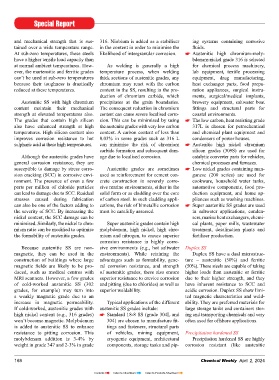Page 168 - CW E-Magazine (2-4-2024)
P. 168
Special Report
and mechanical strength that is sus- 316. Niobium is added as a stabiliser ing systems containing corrosive
tained over a wide temperature range. in the content in order to minimise the fluids.
At sub-zero temperatures, these steels likelihood of intergranular corrosion. Austenitic high chromium-moly-
have a higher tensile load capacity than bdenum-nickel grade 316 is selected
at normal ambient temperatures. How- As welding is generally a high for chemical process machinery,
ever, the martensitic and ferritic grades temperature process, when welding lab equipment, textile processing
can’t be used at sub-zero temperatures thick sections of austenitic grades, any equipment, drug manufacturing,
because their toughness is drastically chromium may react with the carbon heat exchanger parts, food prepa-
reduced at these temperatures. content in the SS, resulting in the pro- ration appliances, surgical instru-
duction of chromium carbide, which ments, surgical/medical implants,
Austenitic SS with high chromium precipitates at the grain boundaries. brewery equipment, saltwater boat
content maintain their mechanical The consequent reduction in chromium fittings and structural parts for
strength at elevated temperatures also. content can cause severe localised corro- coastal environments.
The grades that contain high silicon sion. This can be minimised by using The low carbon, heat resisting grade
also have enhanced strength at high the austenite grades with very low carbon 317L is chosen for petrochemical
temperatures. High silicon content also content. A carbon content of less than and chemical plant equipment and
improves corrosion resistance to hot 0.03% in some grades such as 316 L condensers of power houses.
sulphuric acid at these high temperatures. can minimise the risk of chromium Austenitic high nickel chromium
carbide formation and subsequent dam- silicon grades (309S) are used for
Although the austenitic grades have age due to localised corrosion. catalytic converter parts for vehicles,
general corrosion resistance, they are chemical processes and furnaces.
susceptible to damage by stress corro- Austenitic grades are sometimes Low nickel grades containing man-
sion cracking (SCC) in corrosive envi- used as reinforcement for cement con- ganese (200 series) are used for
ronment. The presence of even a few crete construction in severely corro- cookware, household water tanks,
parts per million of chloride particles sive marine environments, either in the automotive components, food pro-
can lead to damage due to SCC. Residual solid form or as cladding over the core duction equipment, and home ap-
stresses caused during fabrication of carbon steel. In such cladding appli- pliances such as washing machines.
can also be one of the factors adding to cations, the risk of bimetallic corrosion Super austenitic SS grades are used
the severity of SCC. By increasing the must be carefully assessed. in saltwater applications, conden-
nickel content, the SCC damage can be sers, marine heat exchangers, chemi-
minimised. Similarly, the nickel to chro- Super austenitic grades contain high cal plants, paper mills, wastewater
mium ratio can be modified to optimise molybdenum, high nickel, high chro- treatment, desalination plants and
the formability of austenitic grades. mium and nitrogen, to ensure superior fertiliser production.
corrosion resistance in highly corro-
Because austenitic SS are non- sive environments (e.g., hot saltwater Duplex SS
magnetic, they can be used in the environments). While retaining the Duplex SS have a dual microstruc-
construction of buildings where large advantages such as formability, gene- ture – austenitic (50%) and ferritic
magnetic fields are likely to be pro- ral corrosion resistance, and strength (50%). These steels are capable of taking
duced, such as medical centres with of austenitic grades, these also ensure higher loads than austenitic or ferritic
MRI scanners. However, a few grades superior resistance to crevice corrosion due to their higher strength, and they
of cold-worked austenitic SS (302 and pitting (due to chlorides) as well as have inherent resistance to SCC and
grades, for example) may turn into superior weldability. acidic corrosion. Duplex SS show limi-
a weakly magnetic grade due to an ted magnetic characteristics and weld-
increase in magnetic permeability. Typical applications of the different ability. They are preferred materials for
If cold-worked, austenitic grades with austenitic SS grades include: large storage tanks and containers stor-
high nickel content (e.g., 316 grades) Standard 18-8 SS (grade 304L and ing and transporting chemicals and very
won’t become magnetic. Molybdenum 304) are chosen to manufacture fit- often used for offshore applications.
is added to austenitic SS to enhance tings and fasteners, structural parts
resistance to pitting corrosion. This of vehicles, mining equipment, Precipitation hardened SS
molybdenum addition is 3-4% by cryogenic equipment, architectural Precipitation hardened SS are highly
weight in grade 347 and 2-3% in grade components, storage tanks and pip- corrosion resistant (like austenitic
168 Chemical Weekly April 2, 2024
Contents Index to Advertisers Index to Products Advertised

